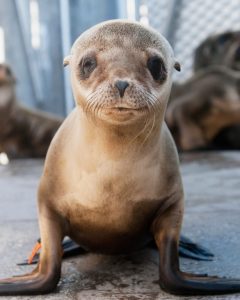
SeaWorld has rescued more than 40,000 injured, sick, and orphaned animals combined at SeaWorld San Diego and its two other major U.S. marine mammal parks since it first rescued a beached Dall’s porpoise in 1965. More than 21,000 of those animals were rescued by SeaWorld San Diego.
Surpassing that milestone underscores the never-ending need to help distressed animals, which SeaWorld’s Rescue and Rehabilitation teams accomplish on call 24/7/365.
Seaworld Parks and Entertainment headquartered in Orlando, Fla., owns and operates 13 U.S. recreational destinations including eight theme parks and five water parks. The company partners with multiple government agencies, including conservationists, stranding networks, zoological facilities, and others to rescue and help needy animals. The park’s goal is always to rehabilitate injured animals, then return them back to the wild.
Such is the case with SeaWorld San Diego’s Rescue and Rehabilitation team, which divides its time between nursing pinnipeds and other marine mammals, along with rehabbing many local seafaring birds.
Jeni Smith, supervisor of SeaWorld San Diego’s Rescue Department, discussed the park’s procedure for rescuing distressed animals.
“We get the description of the animal, why they’re calling and their location, and we also try to get a photo so we can look at what we’re dealing with,” Smith said, adding that recovered wildlife are then retrieved for rehab using the park’s four-wheel-drive, sand-capable rescue truck. “Of the 40,000 rescues, more than half of them have been birds.”
“Jeni had an exciting morning (May 6) actually returning eight (rehabbed) sea lions back to the ocean by boat,” noted Tracy Spahr of SeaWorld public relations.

“A lot of them were dehydrated, one had a shark bite,” noted Smith of those repatriated pinnipeds, referencing a chart on the outside wall of the park’s critical-care unit tracking animals brought in for rehab and return. “These are our up-to-date numbers since April 27,” she said pointing to the wall chart, which totaled 232 animals including 35 California sea lions, one harbor seal, one northern elephant seal, eight fur seals, and 187 birds.
“Our teams are responsible for the care and well-being of thousands of animals – both those rescued and in residence – and while we’d much rather live in a world where wildlife doesn’t need our help to thrive in healthy abundance, that’s not today’s reality,” said Dr. Chris Dold, chief zoological officer for SeaWorld Parks and Entertainment.
“Rescue and rehabilitation can save the lives of individual animals, and in some cases supports the preservation of endangered and threatened species. That is why we do this work, and why it is so important for accredited zoos and aquariums like ours to continue efforts to help animals that cannot survive on their own.”
The number of animals being rehabilitated by SeaWorld at any given time can change dramatically. In 2015, there was a major die-off of San Diego sea lions when their usual food sources temporarily left. The cause was believed to have been a rapid change in ocean temperature. Park staff literally force-fed animals brought in to keep them from starving.
“Sometimes they (pinnipeds) have to re-learn how to eat and how to swallow,” said Smith of how serious rehabilitating rescued animals can sometimes become, which generally takes about two months, depending on the species and circumstances involved.

On the other side of the park in the bird rescue area, Nick DeNezzo, marine wildlife rescue and rehab specialist, was busy tending his flock of sick and injured seabirds.
“There’s a lot of variety,” he said admitting he’s become especially fond of waterfowl having worked closely with them. “Mammal side was cool because sea lions are very interesting and unique. But what I like about birds is that we have over 500 different bird species that either live or pass through San Diego, so there’s a lot of different things we can work with here.”
Added DeNezzo: “Each case is completely different. Some birds have broken wings. Some have parasite or stomach issues. There are entanglements (fishing lines), and oiled animals. It’s a lot of problem-solving, which I like, the variety and the challenge of it. Our rescue total can be 500 to 1,000 birds each year.”
Right now, DeNezzo said SeaWorld’s dealing with injured pelagic (offshore) birds washing up onshore due to storms or other conditions. “Sometimes they’re just weak,” he said adding, “With a sea bird, their plumage is one of the most important things keeping them waterproof. And if they’re not waterproof, they can’t live out on the water.
“So we have a lot of birds where their feathers, whether it’s a nutritional issue or something else, are not doing well. So we’re trying to get them waterproofed. We’re trying to troubleshoot to keep them healthy without pushing them too hard and stressing them out. They can’t talk to us and tell us what’s going on. So we have to figure it out.”

RESCUE & REHABILITATION PROGRAM
· Rescue and rehabilitation are a vital first step in species preservation.
· Dozens of species, including many threatened and endangered animals, have been helped by SeaWorld since 1965.
· One of the largest marine animal rescue organizations in the world, SeaWorld has rescue and rehabilitation operations located at each of its three parks.
· SeaWorld is a professionally accredited zoo and expertise from 50-plus years of animal care and study is what makes successful rescue and rehabilitation possible.
· Providing critical and specialized care to rescued animals provides knowledge that cannot be replicated by the study of animals outside of human care alone.
· SeaWorld provides long-term care in its parks to rescued animals deemed non-returnable by wildlife authorities.
· A portion of proceeds from SeaWorld tickets and in-park purchases goes toward funding rescue and rehabilitation operations.
· The more than 40,000 animals rescued span diverse species such as aquatic birds, pinnipeds, turtles, manatees, whales, dolphins, otters, and a wide range of other mammals and fish.









